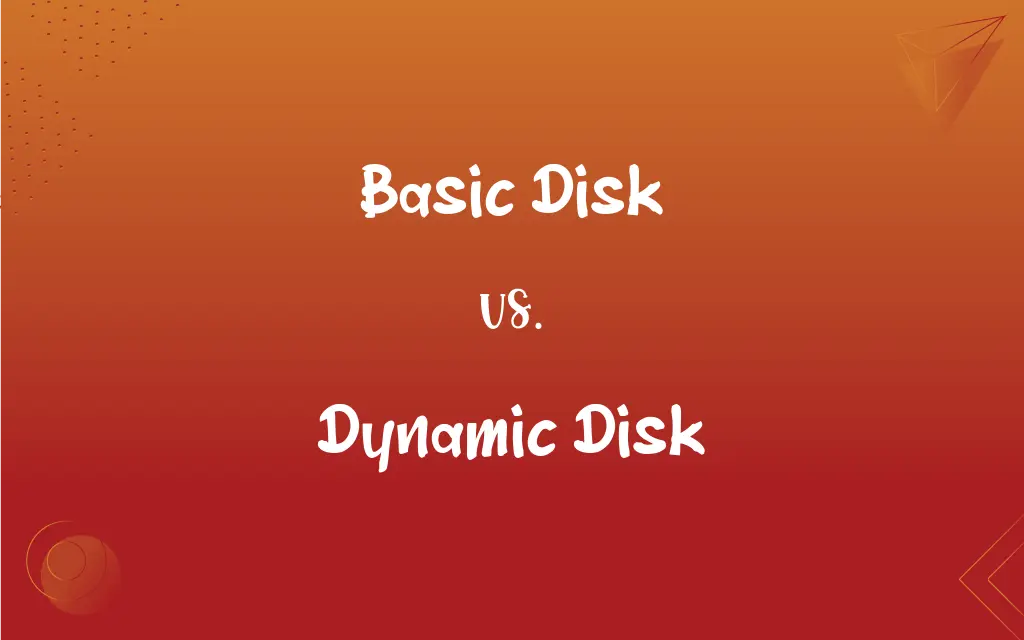Basic Disk vs. Dynamic Disk: What's the Difference?
Edited by Aimie Carlson || By Harlon Moss || Published on January 28, 2024
Basic disks use primary and extended partitions for storage, while dynamic disks use volumes that can span across multiple disks and offer advanced features like fault tolerance.

Key Differences
Basic disks use traditional partition schemes with primary and extended partitions. Dynamic disks, however, utilize volumes that can span multiple disks and offer more flexibility in storage management.
Basic disks are simpler and compatible with all systems but lack advanced features. Dynamic disks offer more advanced features like volume spanning, striping, mirroring, and RAID configurations.
Basic disks are universally supported across different versions of Windows and other operating systems. Dynamic disks are supported mainly in newer versions of Windows and may not be compatible with some older systems.
Basic disks are easy to set up and manage, making them suitable for most general users. Dynamic disks require more management and are more suited for advanced users or specific storage needs.
Basic disks do not inherently support fault tolerance. Dynamic disks, on the other hand, can be configured for fault tolerance through mirroring or RAID setups, offering better data protection.
ADVERTISEMENT
Comparison Chart
Partitioning System
Uses primary and extended partitions
Uses volumes that can span multiple disks
Advanced Features
Limited features; simpler management
Supports striping, mirroring, RAID configurations
Compatibility
High compatibility with all operating systems
Limited to newer Windows versions, less universal
User Suitability
Ideal for general users and basic storage needs
Better for advanced users with complex storage needs
Fault Tolerance
No inherent fault tolerance
Can be configured for fault tolerance
ADVERTISEMENT
Basic Disk and Dynamic Disk Definitions
Basic Disk
The default disk type in Windows installations.
The new laptop came with a basic disk configuration.
Dynamic Disk
A disk type that supports volumes spanning multiple disks.
Their server used a dynamic disk for increased storage capacity.
Basic Disk
Traditional disk type for simple storage needs.
For her personal use, she preferred a basic disk setup.
Dynamic Disk
Suitable for complex storage solutions and RAID setups.
The dynamic disk was set up with a RAID 5 configuration for fault tolerance.
Basic Disk
A storage disk using primary and extended partitions.
The computer's basic disk had three primary partitions.
Dynamic Disk
Allows resizing and extending volumes without rebooting.
The dynamic disk enabled them to extend the volume without downtime.
Basic Disk
A disk format compatible with all operating systems.
The basic disk was easily accessible on both Windows and Linux.
Dynamic Disk
A Windows-specific disk format for advanced users.
He converted the basic disk to a dynamic disk for more flexibility.
Basic Disk
A disk type without advanced features like RAID.
He used a basic disk for straightforward file storage.
Dynamic Disk
Offers advanced features like mirroring and striping.
To enhance performance, they configured striping on the dynamic disk.
FAQs
What are the advantages of a dynamic disk?
Advantages include flexibility, volume spanning, and fault tolerance.
What is a basic disk?
A disk type using traditional partition schemes for data storage.
Can I convert a basic disk to a dynamic disk?
Yes, conversion is possible in most modern Windows systems.
How easy is it to manage a basic disk?
Basic disks are easy to manage, suitable for general users.
Can basic disks be used for dual-boot systems?
Yes, they are well-suited for dual-boot configurations.
How does a dynamic disk differ from a basic disk?
Dynamic disks offer advanced features like volume spanning and fault tolerance.
Is a basic disk better for simple storage needs?
Yes, it's more straightforward and compatible for basic storage.
Are dynamic disks compatible with all operating systems?
No, they are mainly compatible with newer versions of Windows.
How do I create partitions on a basic disk?
Partitions can be created using Windows Disk Management or third-party tools.
Do I need special software to manage a dynamic disk?
Dynamic disk management is integrated into Windows Disk Management.
Are dynamic disks suitable for small businesses?
Yes, especially for businesses with complex storage needs.
How does striping work on dynamic disks?
Striping distributes data across multiple disks to improve performance.
Can I use RAID with a basic disk?
RAID configurations require a dynamic disk setup.
What is disk mirroring in dynamic disks?
Disk mirroring creates identical copies of data for redundancy.
Is there a capacity limit for basic disks?
Basic disks have limitations based on the partition style (MBR or GPT).
Do basic disks support external drives?
Yes, external drives can be formatted as basic disks.
Can I switch back from a dynamic disk to a basic disk?
Yes, but it typically requires data backup and disk reformatting.
Is data safer on a dynamic disk?
Dynamic disks can be configured for greater data safety with RAID.
What is volume spanning in dynamic disks?
It allows combining space from multiple disks into a single volume.
Can dynamic disks improve server performance?
Yes, particularly through striping and RAID configurations.
About Author
Written by
Harlon MossHarlon is a seasoned quality moderator and accomplished content writer for Difference Wiki. An alumnus of the prestigious University of California, he earned his degree in Computer Science. Leveraging his academic background, Harlon brings a meticulous and informed perspective to his work, ensuring content accuracy and excellence.
Edited by
Aimie CarlsonAimie Carlson, holding a master's degree in English literature, is a fervent English language enthusiast. She lends her writing talents to Difference Wiki, a prominent website that specializes in comparisons, offering readers insightful analyses that both captivate and inform.






































































